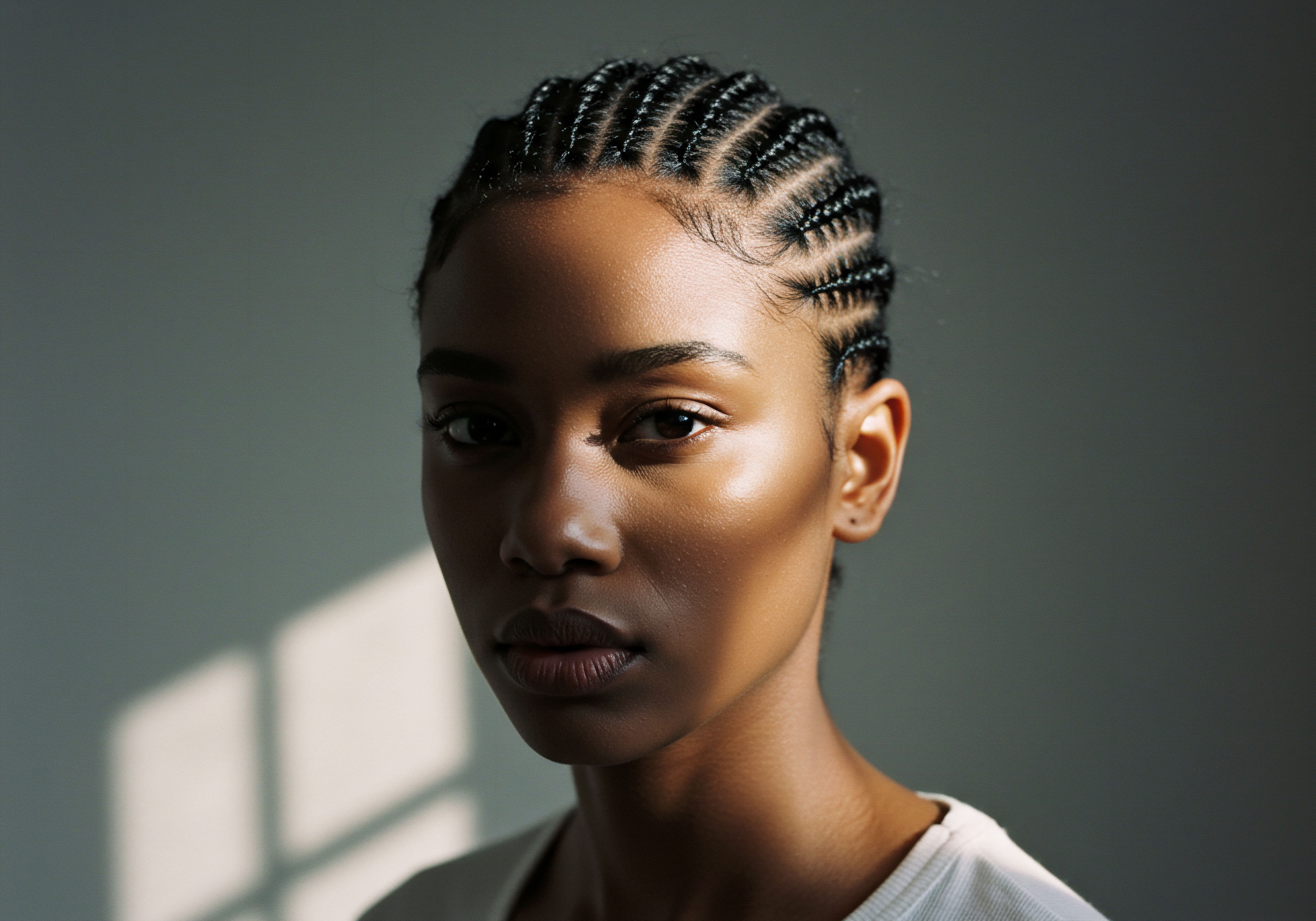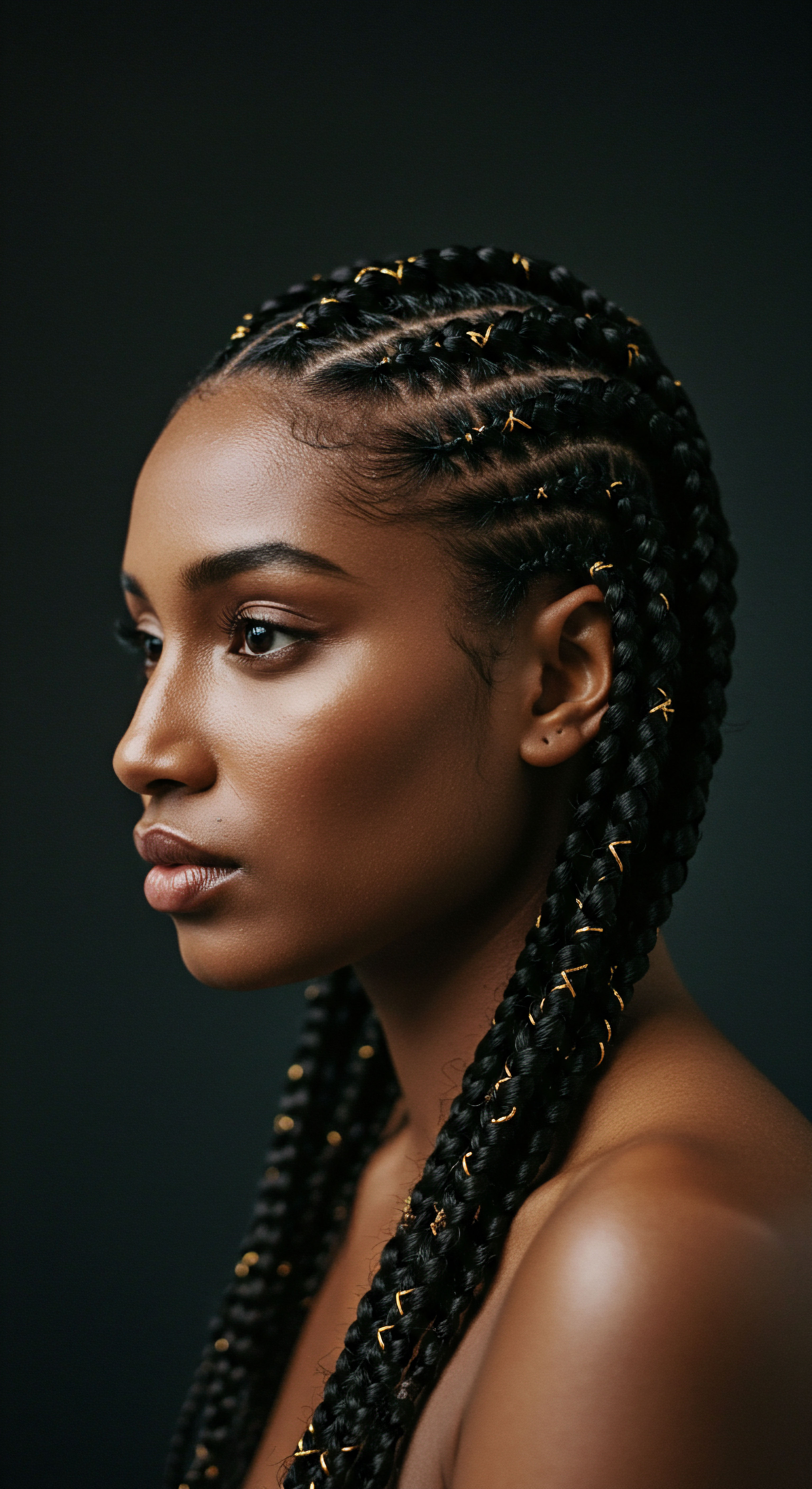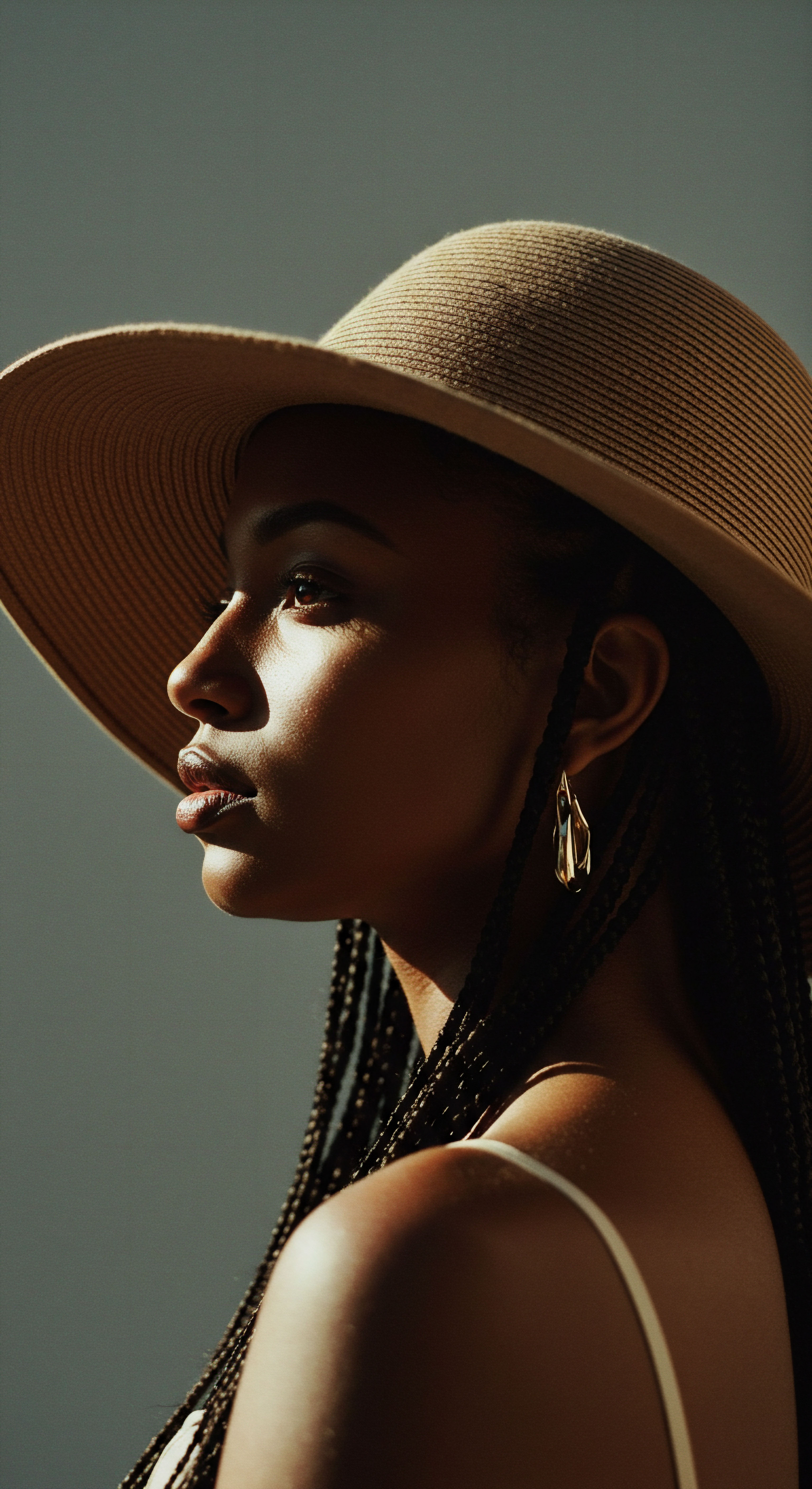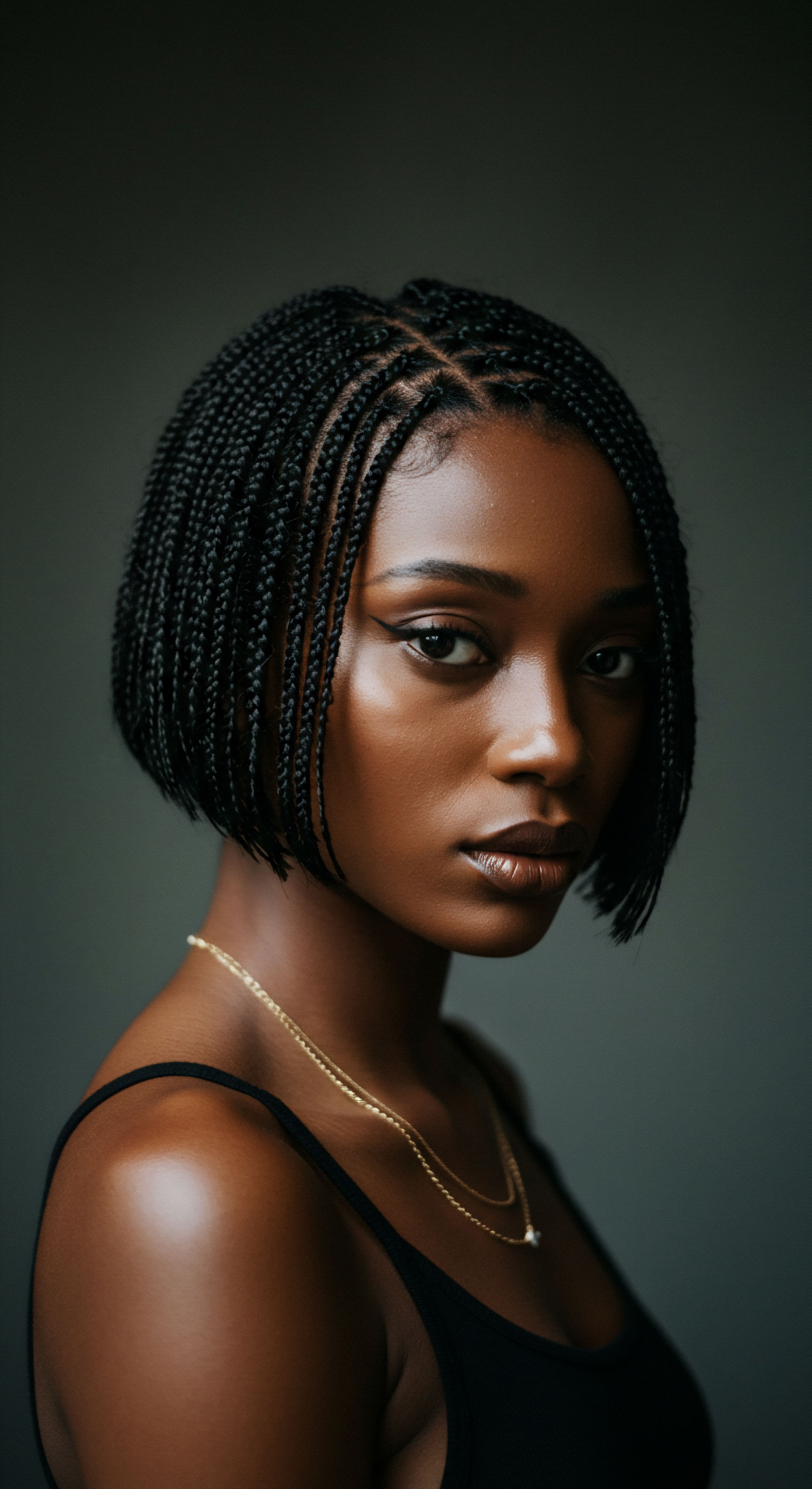The desert, with its unyielding sun and pervasive sand, seems an unlikely canvas for the meticulous artistry of hair care. Yet, within the ancient Egyptian civilization, a deep understanding of the environment and a reverence for personal presentation coalesced to shape sophisticated routines for their strands. This exploration delves into how the arid conditions of the Nile Valley spurred ingenious solutions, transforming hair care from a simple act of hygiene into a complex interplay of science, ritual, and cultural identity.

Roots
The ancient Egyptian landscape, dominated by the relentless sun and dry, sweeping winds, presented a constant challenge to human existence. Beyond the daily need for sustenance and shelter, a more subtle, yet equally persistent, concern shaped their lives ❉ the well-being of their hair. For us, perhaps a casual glance in a mirror confirms a good or bad hair day, but for the ancient Egyptians, the state of one’s hair was a profound reflection of health, social standing, and even spiritual purity.
The very air they breathed, laden with fine desert dust, conspired against hair’s natural vitality, demanding a level of dedication to its preservation that speaks volumes about their priorities. This foundational understanding of their environment’s impact on personal appearance forms the bedrock of our journey into their hair care practices.

The Desert’s Unyielding Grip on Strands
Life along the Nile was a delicate balance against the forces of nature. The intense solar radiation, a constant companion in the Egyptian desert, could render hair brittle and prone to breakage. This exposure, combined with the low humidity, created an environment where moisture loss was a daily reality for hair.
Furthermore, the ubiquitous fine sand, carried by the wind, acted as a constant abrasive, working its way into the hair shaft and scalp, contributing to dryness and potential irritation. These environmental pressures meant that merely washing hair was insufficient; a robust system of protection and replenishment was paramount.
The desert’s arid breath compelled ancient Egyptians to devise intricate hair care strategies for protection and restoration.
The challenge extended beyond simple aesthetics. The harsh conditions could also lead to scalp discomfort and even parasitic infestations. For a society that valued cleanliness and purity so highly, such issues were not merely inconveniences but matters of social and religious significance. The practical need to shield hair from the elements intertwined with a deeper cultural imperative to maintain a polished appearance, a symbol of one’s place within the societal structure and one’s connection to the divine.

Early Insights into Hair Vulnerability
Long before modern trichology, the ancient Egyptians possessed an intuitive grasp of hair’s fragility in their climate. Archaeological findings, from combs and hairpins to cosmetic jars, speak to a culture deeply invested in hair adornment and maintenance from the earliest periods. They observed how hair reacted to the sun’s glare and the sand’s relentless assault, leading them to experiment with various natural resources to counteract these effects. Their solutions, often drawn from the very flora and fauna of their surroundings, demonstrate a keen observational intelligence.
- Sun Exposure ❉ The intense UV radiation from the desert sun could weaken hair proteins, leading to brittleness and color fading.
- Arid Air ❉ Low humidity levels caused hair to lose moisture rapidly, resulting in dryness and a lack of elasticity.
- Sand Abrasion ❉ Fine desert sand particles, carried by winds, could abrade the hair cuticle, leading to damage and dullness.
- Hygiene Challenges ❉ The hot climate increased perspiration and the likelihood of scalp issues, requiring frequent cleansing.
This early recognition of hair’s needs laid the groundwork for the elaborate routines and specialized products that would become hallmarks of ancient Egyptian beauty culture. It was a testament to their adaptability and their unwavering commitment to personal well-being, even in the face of environmental adversity.

Ritual
As we move from the foundational understanding of the desert’s influence, our focus shifts to the deliberate, almost sacred, practices that ancient Egyptians developed to care for their hair. This realm of “Ritual” is where practical wisdom found its expression in daily routines, where techniques were honed, and where the bounty of the Nile and the desert fringe became the raw materials for hair health. It was a space of shared knowledge, where gentle guidance, often passed down through generations, shaped the very approach to personal presentation.

Cleansing and Purification How Did They Wash Their Hair?
Maintaining cleanliness in a hot, dusty environment was paramount, and hair was no exception. While the concept of modern shampoo was far off, ancient Egyptians employed sophisticated cleansing methods. They likely used water from the Nile, sometimes mixed with natron, a naturally occurring salt, or plant extracts with saponifying properties.
These substances helped to remove accumulated dust, sweat, and oils, leaving the hair and scalp feeling refreshed. The daily bath, often in the Nile for commoners or in private facilities for the elite, served as the primary cleansing ritual, ensuring that hair was purified along with the body.
The act of cleansing was not merely about physical removal of dirt; it held symbolic weight, signifying purity and readiness for social and religious engagement. This deep-seated value of hygiene meant that even basic workers received body oils as part of their wages, highlighting the societal importance of maintaining a clean and well-groomed appearance.

The Power of Oils and Balms
Perhaps the most significant countermeasure against desert dryness was the widespread use of oils and balms. These were not merely cosmetic additions; they were essential protective barriers and nourishing agents. Animal fats, often mixed with plant extracts and resins, served as the base for many of these preparations.
Castor oil, moringa oil, and almond oil were among the favored choices, valued for their hydrating and strengthening properties. These emollients would be massaged into the scalp and hair, creating a protective layer against the sun and wind, sealing in moisture, and imparting a healthy sheen.
Ancient Egyptian hair care, driven by desert realities, prioritized deep hydration and protection through natural oils and elaborate styling.
The application of these oils was a regular practice, sometimes even daily, reflecting an understanding that consistent conditioning was vital in their arid climate. The richness of these balms also aided in styling, providing hold and a polished finish to intricate hairstyles.
| Ingredient Castor Oil |
| Source Castor bean plant |
| Proposed Benefit for Hair Hydration, strengthening, shine, promoting growth |
| Ingredient Moringa Oil |
| Source Moringa tree seeds |
| Proposed Benefit for Hair Lightweight moisture, antioxidant properties, scalp nourishment |
| Ingredient Almond Oil |
| Source Almond kernels |
| Proposed Benefit for Hair Moisturizing, softening hair |
| Ingredient Animal Fats |
| Source Various animal sources |
| Proposed Benefit for Hair Base for balms, emollients, styling hold |
| Ingredient Henna |
| Source Lawsonia inermis plant |
| Proposed Benefit for Hair Coloring, strengthening, conditioning |
| Ingredient These ingredients were often combined to create tailored preparations for hair health and styling. |

Wigs and Protective Styling Why Did Egyptians Wear Wigs?
Perhaps the most striking aspect of ancient Egyptian hair care, and one directly tied to the desert environment, was the widespread adoption of wigs. Wigs served multiple practical purposes. They offered superior protection from the intense sun, shielding the scalp from sunburn and preventing excessive moisture loss from natural hair.
Furthermore, they provided a defense against lice, a persistent problem in any densely populated ancient society. Priests, in particular, often shaved their heads for ritual purity, relying on wigs for both protection and social presentation.
Wigs were crafted with remarkable skill, often from human hair, sometimes combined with plant fibers or sheep’s wool, and secured with beeswax and resin. The elite could afford elaborate, heavy wigs, sometimes weighing up to 3 kilograms, signaling their wealth and status. For those who could not afford full wigs, hair extensions were a popular alternative, providing added volume and length.
Beyond wigs, natural hair, when worn, was often styled in protective ways. Braids and plaits were common, keeping hair contained and minimizing exposure to dust and sun. These styles also helped to distribute conditioning oils evenly, further protecting the hair shaft. The practice of “gelling” hair with fat-based substances, as revealed by analyses of mummified hair, suggests a conscious effort to set styles and maintain their integrity against the elements.
A study examining hair samples from 18 mummies, some preserved naturally in the dry desert sand, found that nine of them had hair coated in a fat-like substance containing biological long-chain fatty acids like palmitic and stearic acids. This suggests a widespread use of a styling product, akin to a modern hair gel, to maintain elaborate hairdos in both life and death. This archaeological evidence, stemming from research on mummies from sites like the Dakhleh Oasis, offers a tangible link between the harsh desert climate and the practical measures taken to preserve hair’s appearance.

Relay
Our understanding of ancient Egyptian hair care moves now into a more sophisticated realm, where the interplay of science, cultural meaning, and societal structure becomes clear. This section endeavors to peel back the layers, revealing not just what they did, but why it mattered so deeply, drawing connections that transcend millennia. The very act of caring for hair, in their arid world, was a complex expression of identity, belief, and an enduring quest for wellness.

Hair as a Symbol of Status and Identity What Did Hair Convey in Ancient Egypt?
Hair in ancient Egypt was never merely a biological attribute; it was a potent symbol, a canvas upon which social status, gender, age, and even religious devotion were displayed. The meticulous grooming and elaborate styling, often involving wigs, served as a visual language understood by all. For the elite, a voluminous, perfectly coiffed wig was a clear indicator of wealth and power, a testament to their ability to afford skilled wigmakers and precious materials. Men of high rank often wore wigs that were distinctly different from those of women, and even within genders, specific styles communicated nuances of social standing.
Conversely, shaven heads for priests symbolized purity and dedication to the gods, a deliberate rejection of worldly adornment in favor of spiritual cleanliness. Children, too, had distinctive hairstyles, such as the “sidelock of youth,” which marked their age and connection to the deity Horus. This deep semiotic layer meant that every strand, every curl, every shaven scalp, held a specific message within the complex social fabric of ancient Egypt.
Ancient Egyptian hair practices, from meticulous grooming to wig use, served as profound indicators of social standing, gender, and spiritual purity.

The Intersection of Hair Care and Ancient Medicine
The pursuit of healthy hair was not divorced from ancient Egyptian medical knowledge. Papyrus texts, such as the Ebers Papyrus, contain numerous remedies for hair-related ailments, including hair loss and graying. While some of these remedies might seem unusual to modern sensibilities—involving ingredients like animal fats from lions, hippos, or snakes, or even hedgehog hair—they represent a systematic approach to addressing hair concerns. These ancient formulations often blended practical ingredients with magical or ritualistic elements, reflecting the holistic worldview of the time.
For example, the widespread use of oils like castor oil, known today for its conditioning properties, was not merely for aesthetics but also likely for its perceived therapeutic benefits for the scalp and hair follicles. The protective qualities of cosmetics, including hair preparations, against the harsh desert environment also extended to health, preventing skin and scalp irritation that could lead to more serious conditions. The emphasis on cleanliness, including hair removal for hygiene and protection against lice, also underscores a practical, health-conscious dimension to their grooming rituals.

Enduring Legacy and Modern Echoes How Do Ancient Practices Resonate Today?
The ingenuity of ancient Egyptian hair care continues to resonate in contemporary practices, particularly within textured hair communities. The principles of protection, moisture retention, and the use of natural oils remain cornerstones of modern textured hair regimens. The ancient Egyptians, through their responses to the desert’s demands, essentially pioneered many concepts that are still relevant today.
Consider the practice of wearing wigs or extensions for protective styling; this ancient solution to environmental challenges and aesthetic desires mirrors the modern use of these elements to shield natural hair from damage and offer styling versatility. The reliance on plant-based oils and fats for deep conditioning and sealing moisture, a direct response to the desert’s aridity, finds a direct parallel in the popularity of natural butters and oils in today’s hair care products for highly porous or curly hair types. The commitment to scalp health, evident in their cleansing and oiling rituals, is also a vital component of modern hair wellness philosophies.
This historical continuity highlights a profound understanding of hair’s needs, developed through generations of lived experience in a challenging climate. The ancient Egyptians, with their sophisticated approach to hair, remind us that the quest for healthy, beautiful hair is a timeless human endeavor, deeply intertwined with our environment, our culture, and our very sense of self.
- Protective Styling ❉ The use of Wigs and elaborate updos to shield natural hair from environmental damage.
- Oil-Based Conditioning ❉ The reliance on Natural Oils and fats to hydrate and protect strands from dryness.
- Scalp Health ❉ The emphasis on Cleansing and nourishing the scalp to prevent irritation and support growth.
| Ancient Egyptian Practice Wearing wigs for protection from sun and lice. |
| Modern Textured Hair Principle Utilizing protective styles (wigs, braids, twists) to minimize manipulation and environmental exposure. |
| Ancient Egyptian Practice Applying animal fats, castor, or moringa oils to hair. |
| Modern Textured Hair Principle Employing natural butters and oils (shea, coconut, jojoba, castor) for deep conditioning and moisture sealing. |
| Ancient Egyptian Practice Shaving heads for hygiene and ritual purity. |
| Modern Textured Hair Principle Prioritizing scalp health through regular cleansing, gentle exfoliation, and targeted treatments. |
| Ancient Egyptian Practice Using henna for coloring and strengthening hair. |
| Modern Textured Hair Principle Exploring natural hair dyes and strengthening treatments that condition and add vibrancy. |
| Ancient Egyptian Practice The challenges posed by the desert environment led to innovations that parallel contemporary textured hair care. |

Reflection
The enduring whispers from the sands of ancient Egypt reveal a profound connection between humanity and its environment, a testament to how even the most relentless conditions can spark remarkable ingenuity. The story of ancient Egyptian hair care is more than a historical footnote; it is a mirror reflecting our own timeless desires for health, beauty, and self-expression. It reminds us that care for our strands, whether in a scorching desert or a bustling city, is an act of gentle resilience, a quiet conversation between our inner selves and the world around us. Their legacy, preserved in papyrus and mummified locks, continues to offer a subtle, yet powerful, invitation to consider the deep roots of our own wellness journeys.

References
- Aufderheide, A. C. Cartmell, L. & Zlonis, M. (2004). The Scientific Study of Mummies. Cambridge University Press.
- Birkett, D. A. Gize, A. P. & David, A. R. (2011). Ancient Egyptian hair gel ❉ New insight into ancient Egyptian mummification procedures through chemical analysis. Journal of Archaeological Science, 38(11), 3230-3234.
- Dawson, W. R. (1927). Magician and Leech ❉ A Study in Ancient Egyptian Medicine. Methuen & Co. Ltd.
- Fletcher, J. (2016). Ancient Hair ❉ The Archaeology of Hair and Hairstyles. Bloomsbury Academic.
- Kandil, H. A. & Salama, M. E. (2018). Role of the Hair in Ancient Egypt. International Journal of Tourism and Hospitality Management, 1(1), 77-85.
- Lucas, A. (1930). Ancient Egyptian Materials & Industries. Edward Arnold & Co.
- McCreesh, N. C. Gize, A. P. & David, A. R. (2011). Ancient Egyptian hair gel ❉ New insight into ancient Egyptian mummification procedures through chemical analysis. Journal of Archaeological Science, 38(11), 3230-3234.
- Menghini, A. (2005). Hygiene and Beauty in Ancient Egypt. Aboca.
- Robins, G. (1999). Hair and the Construction of Identity in Ancient Egypt, c. 1480-1350 B.C. Journal of the American Research Center in Egypt, 36, 55-69.
- Salama, M. E. A. (2024). The Role of the Hair in the Ancient Egyptian Beliefs. ResearchGate.